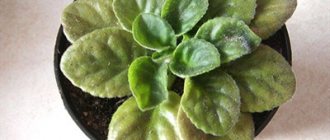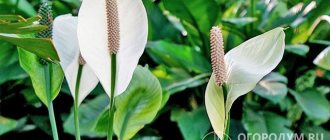- How to make a soil mixture
- Required Items
Usambara violet, or Saintpaulia, has been known in our country since the mid-20th century. Today the plant has been thoroughly studied, there have been significant achievements in the field of breeding, and many articles have been published in popular science magazines. And how many books and brochures have been published containing guides on growing these velvet beauties! But not all beginners are able to immediately achieve the desired result. One of the most frequently asked questions is: how to water violets to make them bloom faster? It is impossible to answer this unequivocally, since feeding is only part of the set of rules for care. If you strictly follow them, the plant will definitely thank you with its lush flowering.
Violets are very popular because they can bloom almost all year round.
We decided to talk in detail about how to properly plant Saintpaulias, water and fertilize them, and where it is best to place them in the house.
Description of the flower with photo
Different types and varieties of indoor violets differ in flowering, shape and size of rosettes, color and shape of foliage. They are grouped into groups that make it easier to distinguish them. There are classic, fancy, bordered, bell violets, star violets, wasp violets and chimera violets. They all have their own flavor and are beautiful in their own way, and each gardener can choose a flower to his liking.
Trending Pilaf with chicken and shrimp
The flowers of indoor violets are simple five-membered or double, with a diameter of 2.5 to 9 centimeters, collected on stalks from 2 to 7 pieces. The color is varied: white, pink, purple, lilac, lilac, blue and two-tone. The core of the flower and the border around the edges of the petals can be painted in contrasting colors.
The violet has a shortened stem. The plant forms a rosette of leaves. In different varieties of violets, the diameter of the rosette ranges from 7 to 45 centimeters. The leaves are elongated oval or round in shape, fleshy, with slightly jagged or smooth edges and succulent cuttings. The color of the foliage, depending on the species, can be from light to dark green. In variegated varieties, the leaves may be interspersed with other (contrasting) colors. The root system is superficial.
The aroma of violet has a beneficial effect on the human body. It improves mood, relieves tension, relieves insomnia, expels negative energy, and has a positive effect on the atmosphere in the house. In addition, the flower does not cause allergies.
Conditions for flowering violets
The abundant flowering of violets is determined at the genetic level. Varieties that, when flowering, form no more than 3 peduncles cannot bloom luxuriantly. In order for a plant to delight with voluminous flowering, you need to choose the right variety and provide it with good care.
Lack of sunlight is a fairly common cause of lack of buds.
Improper placement of flower pots will weaken the violet. This is easy to recognize by the leaves, they stretch upward. Excess light is also dangerous for the flower; it leads to sunburn.
- Daylight hours for violets should be about 12 hours. If it is shorter, then you may not get flowers, and even if it does, it will turn out to be meager and short-lived.
- A violet with dark green, dense foliage requires more light than a flower with light, wavy leaves. The plant should not touch the cold window glass.
- In summer, the air temperature in the room should be 20-24 degrees, in autumn and winter 18 degrees.
- When fertilizing, do not use large amounts of nitrogen fertilizers. They promote the active growth of green mass, while flower stalks appear later. If fertilizers contain a lot of potassium, the violet stops growing and turns yellow.
- Air humidity for comfortable violet conditions should be 50%. If the air is dry, it needs to be artificially humidified.
- You need to water the flower as the soil in the pot dries.
- The soil for growing violets should be light, breathable and loose. Once a year you need to replant the flower in new soil.
- The pot must be small and match the size of the plant, otherwise the violet will not bloom.
- If the plant is more than 3 years old, it needs to be replanted, since flowering occurs only on young rosettes.
Feeding for stimulation
Saintpaulia tolerates a lack of fertilizer better than an excess amount. If the flower has only recently been transplanted, it does not need additional feeding. The root system will receive all the necessary substances from the substrate.
The plant should not be fed if there are several “buts”:
- within a month after transplantation;
- with direct exposure to sunlight;
- in the presence of pests;
- at a temperature that does not correspond to the norm.
Fertilizers are applied when the plant is clearly depleted. It is best to choose products in the form of granules and solutions in a specialized store. Options for feeding violets so they bloom:
- When planting buds, choose products containing phosphorus. It strengthens the root system of Saintpaulia and promotes the formation of a large number of inflorescences.
- An already flowering plant needs more nitrogen. The trace element helps the leaves acquire a rich emerald hue and activates flower growth.
- Fertilizing with potassium fertilizers protects Saintpaulia from diseases. Application of the product ensures lush flowering of bushes all year round.
- It is not often possible to use complex products with calcium, iron, sulfur, magnesium, cobalt, copper and zinc. Calcium strengthens flower stalks, and magnesium and sulfur promote the production of chlorophyll.
It is recommended to apply fertilizing to stimulate flowering no more than once a month, first making sure that the unhealthy appearance of the bush is not due to diseases, pests or care errors, but to a lack of nutrients.
Reasons why violets don't bloom
The lack of flowers occurs due to improper care, uncomfortable conditions for keeping the plant, diseases and pests.
- Violet suffers from direct sunlight.
- Hot air from heating radiators should not touch the flower.
- She loves moderately humid air; direct spraying is not suitable for this.
- Drafts harm the flower.
- Leaves should be cleaned of dust with a soft, damp cloth or brush; they should not be wetted.
- The soil in the pot should not dry out completely or, on the contrary, become waterlogged.
- For irrigation you need to use soft and warm water.
Common mistakes
Failure to follow care recommendations can lead to disastrous consequences. It is important to avoid the following mistakes:
- Fertilizing should be done only for healthy and well-developing flowers.
- Excessive addition of nutrients to the soil can lead to violet disease.
- Fertilizers are applied only after preliminary watering.
- Failure to comply with Saintpaulia nutritional rules.
- Improper spraying can damage the leaf blades.
Healthy flowering of Saintpaulia at home
Caring for violets consists not only of following the rules of cultivation, but also of timely application of fertilizing and fertilizers. The methods can be very diverse. Root or foliar application can be used. The choice of means depends not only on the specific situation, but on the preferences of the grower. Compliance with all the rules will allow you to get a real decoration for any home, which will delight you with its beautiful flowers for many years.
Caring for violets at home
For the growth and development of violets, certain conditions are required. Caring for violets is not difficult. For it you need to provide bright lighting, choose a pot suitable for the size of the plant and ensure timely watering and fertilizing.
Watering
The plant should be watered with settled water at room temperature as the soil dries out. It should not get on the leaves or the growing point of the flower. It is not recommended to water the plant from below into a tray. Harmful salts rise to the top layer of the earth, which leads to the need for frequent soil replacement.
To moisturize, the violet can be sprayed with a spray bottle once a week. Water should be sprayed at a distance so that droplets of moisture do not form on the leaves and flowers, which can lead to their fading. This procedure promotes leaf growth and moisturizes dry indoor air. To further increase the humidity, you need to place containers with water or expanded clay or sphagnum filled with water between the pots.
How to water a violet: video
Reproduction
Violets reproduce using leaf cuttings from which children grow and by seeds.
Leaf
Take the formed leaf from the second bottom row of the flower. Place in a jar of water and place it in a warm, bright place, away from drafts and direct sunlight. After 3.5-4 weeks, roots appear. The cutting is planted in loose soil in a depression of up to 2 centimeters, covered with earth and covered with a jar or plastic bag.
The plant should be watered with settled water. Young violets can be planted with well-formed rosettes and 2-3 pairs of leaves. After 3 weeks, the seated children begin to grow.
How to grow a violet from a leaf: video
Seeds
Interesting on the topic:
Momordica
Mar 5, 2022
Whose saffron is better: a unique spice from Imeretian...
Mar 4, 2022
Growing a flower from seeds. You can buy ready-made seeds or collect them yourself. In this case, you need to place two flowers of different sexes next to each other. After pollination, a queen box appears. When it dries, you can collect the seeds. They are sown in furrows, and after they germinate and reach 3-4 centimeters in height, the plants are planted in pots.
Transfer
If the crown of the plant greatly exceeds the size of the pot or the roots have completely filled the pot and are breaking through the drainage holes, the plant needs to be transplanted into a larger pot.
This is done after the violet has finished flowering. Transplanting into new soil every 6-12 months allows you to saturate the plant with nutrients. In this case, you need to preserve the earthen ball on the roots as much as possible, then the plant will quickly grow.
If replanting is not required, you can simply feed the flower with special fertilizers.
Land for adult violets should include:
- 1.5 kilograms of leafy soil,
- 800 grams of peat,
- 300 grams of perlite, vermiculite or coarse sand,
- 100 grams of coconut substrate,
- 100 grams of chopped sphagnum moss,
- 20 grams of crushed charcoal.
Uncut sphagnum or vermiculite is used as drainage.
The diameter of the flower rosette should be 3 times larger than the diameter of the pot. Large varieties of violets can also be planted in large pots with a diameter of 13 centimeters (for an annual plant). In small pots, large varieties cannot gain leaf mass, which leads to a lack of buds.
How to replant violets: video
Winter care
- In winter, the flower needs to be provided with additional lighting.
- The air temperature should not drop to 17 degrees Celsius.
- If the flower is on a south-facing window, it should be protected from direct sunlight with a transparent curtain or white paper.
- The leaves of the flower should not touch the cold window.
- During the winter period, one feeding is enough for the plant.
Water for irrigation
Not all water is suitable for watering violets. If it is hard and too mineralized, then soil salinization will occur, and spots or white coating will begin to form on the leaf blades. Water for watering or irrigation should be settled and at room temperature. It is advisable to use melt or rain water for these purposes.
You can soften the water using special filters, adding apple or table vinegar to it, or by adding wood ash or peat. Only this kind of water can be used to spray and water violets.
Diseases and pests
Signs of disease or the presence of pests can be noticed even by a beginner in floriculture. Most often, violets are affected by diseases and pests such as fusarium, powdery mildew, gray rot and scale insects, aphids, and mites.
Fusarium is a fungus that causes flower roots to rot. The disease appears due to cold water and frequent watering of the flower. This is manifested by the absence of flowers, the leaves turn gray and fall off. To eliminate the disease, Fundazol and Benomyl are used.
Powdery mildew is an infection that appears when there is a lack of light, low plant temperature (below 18 degrees), or accumulation of dust. It forms a white coating that appears on the stems of the plant. To eliminate the disease, a special remedy, Benlat, is used. The flower stems should be regularly wiped with a slightly damp cloth, and the room should be ventilated daily.
Gray rot appears after frequent watering of the plant with cold water and temperature changes in the room. On petioles and foliage, the disease manifests itself as a gray, fluffy coating. To combat the disease, Agate, Thiram and Fitosparin are used.
Pests can be found quite often on violets. Scale insects appear on the roots of the flower. Pests are easy to recognize if you remove the plant from the pot and free the roots from the soil. The violet is also covered with small red spots. Fitoverm is used to eliminate the pest. The roots are cleared of soil, washed and treated with Aktara.
Aphids appear in residential areas with store-bought flowers or flowers brought from the country. The aphid drinks the juice from the plant and attacks the buds and flowers. Emerging pests are destroyed with a soap solution, and in case of severe damage, with Mospilan or Actellik.
Mites appear as red dots and cobwebs on the foliage. Round yellow spots appear on the plant. The affected flower is treated with Actellik.
How to apply fertilizers
There are two generally accepted methods of applying fertilizer: root and foliar. It is believed that the use of root feeding is more effective. In this case, the root system receives the maximum amount of useful microelements.
Root feeding
The solution should be prepared using warm water. Cold water is harmful to violets. When root feeding using purchased fertilizers, the concentration of the solution should be reduced. The main thing is to prevent the drug from getting on the leaves and flowers.
Applying fertilizer at the root
Foliar feeding
This procedure is carried out only with special means. It is necessary to use sprayers capable of spraying using the “fog method”.
When performing the process of sprinkling violets, maximum care is required.
Spraying procedure
Attention! Overmoistening of the sheet plate is not allowed.
Spraying can be carried out only on healthy and undamaged plants and only in the evening. The concentration of the drug should be halved compared to root watering. This method of feeding cannot be used more than 4 times during the entire spring-summer season.
Wick feeding
The technique of feeding using the wick method is simple. Through the wick, the violet will take only the required amount of nutrients. The container with micronutrients is located under the violet pot, and the string will be a source of liquid delivery to the roots.
Wick irrigation with fertilizers
The use of wick feeding is allowed throughout the entire period of Saintpaulia development.
What to do to make the violet bloom
Peduncles form only in good lighting. Flowers are equally important to the duration and intensity of lighting. If the violet grows in a window of abundant flowering, you can wait until closer to May. Every day the violet should be illuminated for 12-14 hours. There is enough light on the window from the beginning of spring to the end of August. In mid-autumn, the lighting period decreases to 8 hours; in winter it becomes even shorter. It is for this reason that violets on the window bloom only in May. On illuminated shelves, violets grow faster and bloom more often. The light from the lamp for illumination should be brighter than for reading.
For violet to bloom abundantly, the root system of the flower must tightly entwine the entire pot, otherwise the flowering will not last long.
To choose the right pot for a violet, you need to follow the rule: the diameter of the rosette in the ratio to the diameter of the pot should be 3:1. For a young flower, a pot with a diameter of 5-6 centimeters is enough; for an adult plant, a pot with a diameter of 12-13 centimeters is enough.











